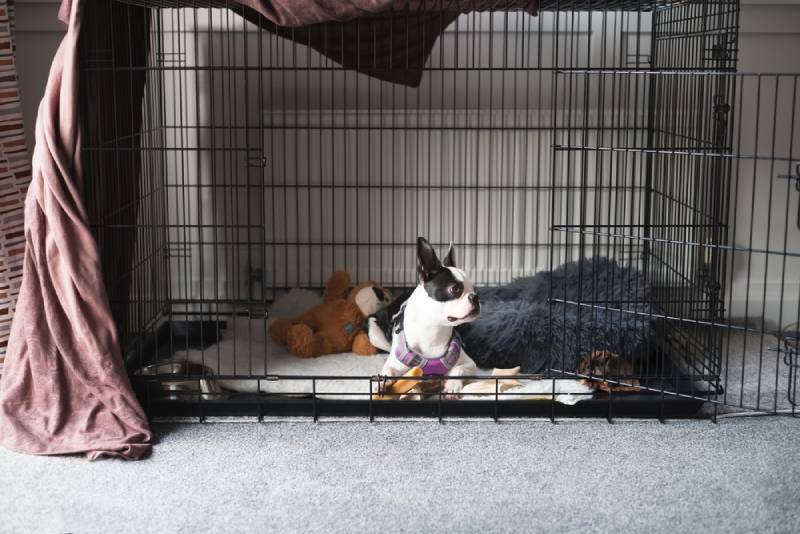I’ve Followed Both Fast-Kill and Slow-Kill Heartworm Treatment Protocols
I’ve fostered a half-dozen (or more) dogs who were diagnosed heartworm positive. Only one received slow-kill treatment, Emmy Lou. She was my crate aversive, please-don’t-leave-me-alone deaf female that lived with me for about two years. Her issues made it unsafe for her to undergo melarsomine therapy because I was unable to keep her calm.
Emmy Lou hated the crate. When you closed the crate door, she anxiously worked herself up into a frenzy. I tried to gently train her to the crate, but she was steadfast in her resistance. Sedatives did not ease her anxiety, either. Even though she had an early stage of heartworm disease, melarsomine therapy was unsafe, as Emmy Lou would not tolerate cage rest. The safer treatment for her was a slow-kill protocol.
Emmy Lou’s slow-kill protocol included the use of Doxycycline and a monthly dose of Heartgard. After testing negative for heartworm, she was adopted by a wonderful family and lived the life of a queen. She died at the age of 11 from a cardiac event. I wish she’d had more time to soak in all the doting she received and deserved.
Don’t let your fear of keeping dogs calm during heartworm treatment influence your treatment choices.
Let’s face it: The thought of keeping your active dog calm during heartworm treatment may want you to shy away from “fast-kill” therapies. I understand! Melarsomine treatment is risky and scary.
The more I understand about heartworm disease and treatment, however, the less I’m afraid of “fast-kill” treatment.
Any heartworm treatment protocol requires planning, commitment, and attention.
But wait – slow-kill is easy, right? Not really, says the American Heartworm Society. “Slow-kill is slow,” says Dr. Clarke Atkins, DACVIM. As long as heartworms are in the dog (up to 30 months with the traditional slow-kill protocol) those worms cause damage. Slow-kill protocols also require exercise restriction for the dog. Why? The answer is straight forward: exercise causes more damage. The American Heartworm Society urges all dogs diagnosed heartworm positive to begin exercise restriction, no matter which treatment protocol you choose to use.
How do I keep my foster dogs calm and happy during both the exercise restriction and cage rest phases of heartworm treatment? Keep reading!
8 Ways to Keep a Hyper Dog Calm After Heartworm Treatment
Cage rest is the canine equivalent of bed rest for humans; you put your dog in a cage and keep them from moving around—except for taking them out several times a day for toilet breaks. When preparing the cage for your dog, ensure that it has enough space for the dog to move around comfortably and that you put in something soft for the dog to sleep on.
If your dog is not used to being caged, then cage rest can cause anxiety and raise your dog’s heart rate, which is what you want to avoid.

Exercise restriction means that your dog should be kept indoors most of the time. When you do take them outdoors, then keep them on a leash so as to restrict your dog’s ability to follow their urges to run off and have fun. During your dog’s time outside, try and keep them away from anything that might excite them, such as other dogs, squirrels, birds, or other animals they like to chase, neighbors, or other people that might interact with your dog.
Obviously, you shouldn’t play any energetic games with your dog, such as running or fetching balls or sticks.
Talking to dog owners about rest and recovery during heartworm treatment
Has your dog been diagnosed with heartworm disease and is currently undergoing treatment? If so, it is important to change your at-home habits to complement your veterinarian’s efforts and give your dog the best chance for a full recovery. Heartworms target a dog’s heart, lungs, and blood, and can bring on potentially fatal health issues without the proper treatment.
Even with treatment, your pup requires additional care and consideration while undergoing treatment. Here are some of Oakland Veterinary Referral Services’ (OVRS) top tips for caring for a dog during heartworm treatment.
Since heartworm disease targets your dog’s cardiovascular and respiratory systems, it is very important to limit physical activity throughout the duration of the treatment. Heartworm disease ranges in severity from stage 1 (where the animal is infected but not showing symptoms) to stage 4 (where the heart and lungs are already damaged and the liver is enlarged). Your veterinarian will talk to you about which stage your dog is dealing with. It affects how much or little physical activity he can safely do without risking further damage. Instead of your daily walk, you might want to instead have a cuddle fest to give your dog’s body a proper chance to heal.
We know it can be difficult to keep your dog from some of her favorite things while she is dealing with heartworm treatment, but it is very important to keep your pup calm to ensure a full recovery. While your dog is undergoing treatment, be sure to avoid the following:
Without regular levels of physical activity, it is important not to overfeed your dog during heartworm treatment. That doesn’t mean you can’t use food to give him a little bit of joy. Invest in a food puzzle or other interactive food game that can keep his mind engaged as he eats to prevent boredom. You can also fill his kennel with some fun chew toys so he can keep his mind busy even while his body rests.
The American Heartworm Society also offers ideas for battling boredom during cage rest while your pet recovers.
If you think your dog might have heartworm disease and needs treatment, the team at OVRS is here for you. To learn more about our specialty or emergency veterinary services, or caring for a dog during heartworm treatment, please call (248) 334-6877.